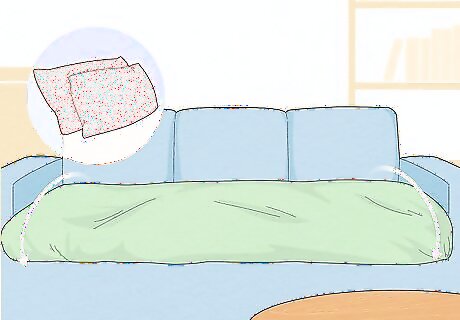
views
- Clean the couch, flip over the seat cushions, and take off the back cushions.
- Pad the couch with blankets and pillows to make it more even and comfortable, then cover it with a top sheet.
- Put extra blankets by the couch, keep the temperature around 65 °F (18 °C), and sleep with an eye mask and ear plugs, if you have them.
Making the Bed

Flip the seats and take off the back cushions. If you can, take out the bottom cushions and flip them. This gives you a firmer, cleaner surface to sleep on. Brush out any crumbs you find. If the back cushions of the couch are detachable, remove them to give yourself a wider area to sleep. Line up the back cushions on the floor along the couch to have a soft surface to land on if you roll off, especially if you’re sleeping on a slippery material like leather.

Pad the couch with blankets. Couches can be hard, saggy, or so soft that you sink into them. To make a hard couch more comfortable, cover it in thick blankets or duvets. If the couch is soft or saggy, pile up blankets under your hips and put a small pillow under your knees. This helps keep your spine in alignment while you sleep. If you’re crashing somewhere and have nothing to pad your bed with, look at your own belongings. Sweatshirts and sweatpants might work if you can lay them flat. Weighted blankets make great hip supports since they’re so hard and bulky.

Put sheets over the padding and pillowcases on your pillows. Once you’ve padded the bed, cover it with an unfitted sheet. Couches can be dirty, so don’t let your skin (especially the skin of your face) lie on it unprotected for long. If you’re using a throw pillow, put it in a pillowcase or a t-shirt. If at all possible, bring your own pillow to the couch, since they’re made for neck support and throw pillows aren’t. Don’t sleep with your head on the arm of the couch. The angle is sharp enough that you could wake up with a really sore neck. If you have no sheets, lay out any soft and clean fabrics you can find. Wear pajamas to avoid contact with the couch fabric.

Consider cleaning the couch. If you know people are sleeping on a couch ahead of time, consider cleaning it more thoroughly. Bring the cushions outside and give them a good whack to get the dust out. Vacuum and brush off any pet hair. Use water and detergent if the material of your couch can take it. Check the tag on your couch to see what kind of cleaning it can handle. The tag may be under the couch next to a leg. It’s marked with a letter that lets you know how to clean the couch. "W" means you can clean your couch with a water-based detergent. "S" means it needs to be dry cleaned or cleaned with a water-free detergent. "WS" means it can be either dry cleaned, or cleaned with a water-based cleaner. "X" means it should be professionally dry cleaned or vacuumed. "O" means it is made of natural fibers and should be washed in cold water
Falling Asleep

Keep the room temperature around 65 °F (18 °C). Temperature affects your quality of sleep, so cool down the room and put extra blankets nearby in case you get cold. Consider opening a window—a room that is slept in less often may be an uncomfortable temperature, or may be stuffy and airless. Weighted blankets can help create a comfortable snuggly feeling, but make sure you don’t get too hot under them.

Close the blinds, wear a sleep mask, and turn off all screens. Sleeping in the dark is extremely important for a good rest. Draw the curtains, wear a sleep mask if you have one, or block the light with a pillow. Living rooms are likely to have blinking screens and LED lights, so consider blocking them from your view with a pillow or cushion. Avoid all blue light from screens for a couple of hours before going to sleep to not disturb your sleep patterns.

Ask other people in the house for quiet or wear earplugs. If you’re sleeping in a full house, there may be people coming in and out, or noise in the morning. If you own earplugs, wear them while you sleep on the couch. Don’t improvise earplugs out of cotton or tissue, as they can get stuck in your ear. Politely ask the other people sleeping in the house to keep it quiet if they can.

Recreate your ordinary bedtime routine. Try to do everything you normally do before bed. For example, if you watch TV, shower, drink a cup of herbal tea, and fall asleep at 10 pm, try to do all those things in that order. Do whatever you normally do in your bed on the couch instead.

Sleep on your back on long couches and in the fetal position on short ones. Even if you’re usually a side sleeper, the easiest way to sleep on a couch (and not fall off!) is on your back. If it isn’t long enough, however, either put your legs over one couch arm, bring over another piece of furniture to stretch out on, or sleep in the fetal position. Lying on your back is the best posture to have while sleeping, because it keeps your spine in alignment. Sleeping on your side or stomach, especially on a couch, can strain your neck. If you find that the couch is too uncomfortable, take the couch cushions and make yourself a mattress on the floor. Some people find floor sleeping (while not ideal) to be more comfortable, especially if they don’t shift around at night.



















Comments
0 comment